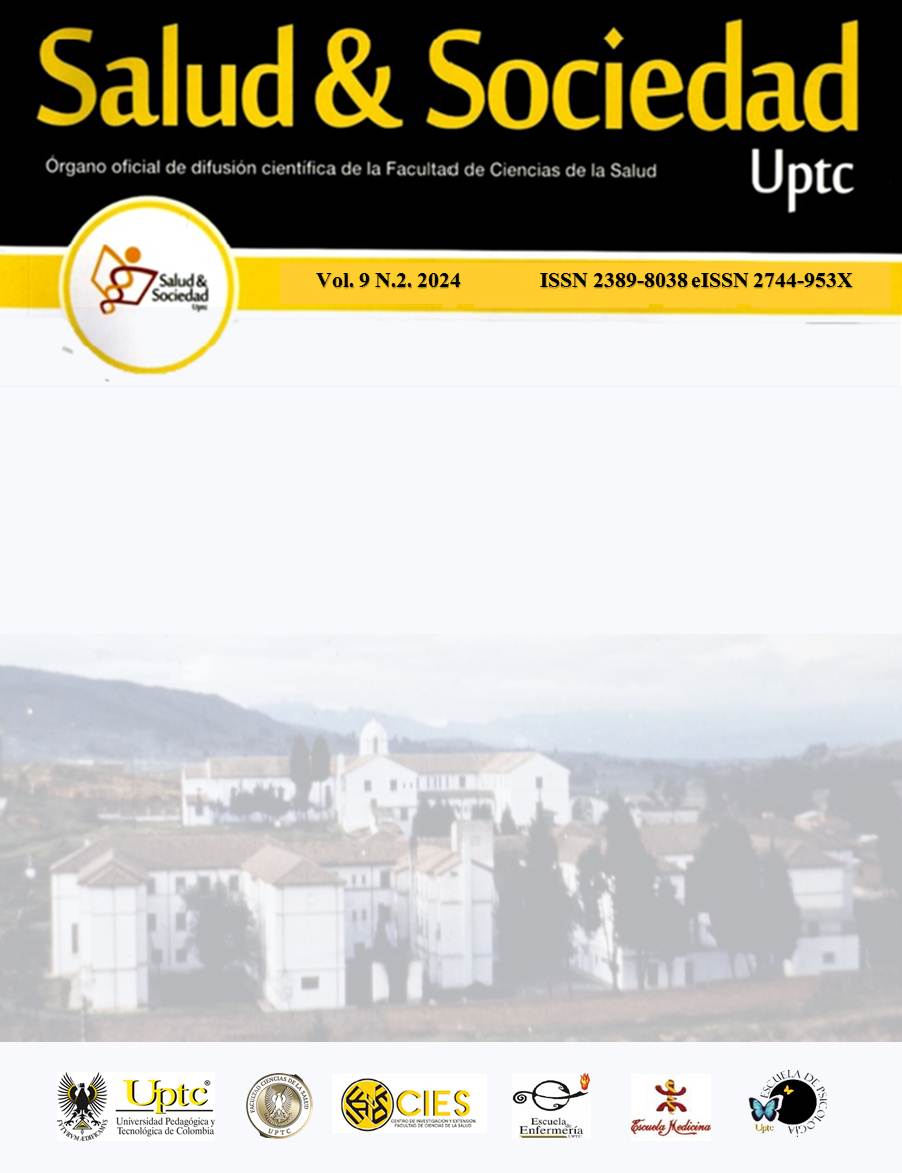Evaluation of proprioception in the student population using the modified Romberg test: effect of an intervention

Abstract
Background: The modified Romberg test is useful in measuring proprioception in adults even with its limited application at present due to lack of consensus and uniformity between the different tests. However, this is a rapid, reliable, reproducible and economical test. Objective: to assess, using the modified Romberg test, the impact on proprioception when a training exercise program is implemented in a university population. Materials and Methods: Observational, quasi-experimental, before-after intervention study, without control group. Sample of 53 medical students from UPTC - Tunja in the period 2022-2. A training intervention was carried out to stimulate proprioception, the impact of which was evaluated using the modified Romberg test before and after training. The information was tabulated and analyzed in the Epi-Info7 software, with descriptive statistics techniques for quantitative variables and contingency tables were designed for categorical variables. Results: an increase in the mean time of the final result compared to the initial one was found for both lateralities and in the same sense a positive difference was found between the final mean result and the initial one, with an initial average for the right leg of 17 seconds and final 21.6 seconds; for the left leg they were 16.6 seconds initially and 21.4 seconds at the end. The average difference for the right leg was 5.09 seconds, which was greater than the difference of 4.75 seconds for the left leg. Conclusion: The modified Romberg test is useful in measuring proprioception; Cut-off point of this test is 20 seconds, results below this are considered a proprioceptive deficit and results above this indicate the proprioceptive state; Proprioception is a poorly studied, exercised and evaluated sense that needs more research and application in the clinic to prevent injuries.
Keywords
Proprioception, Education, Physical training, neurodevelopmental disorders
Author Biography
Nicolas Hernandez Arango
Orthopedic Specialist Physician. Professor School of Medicine Pedagogical and Technological University of Colombia
María Paula Godoy Infante
Internal Physician. Pedagogical and Technological University of Colombia
Sofía González Briceño
Internal Physician. Pedagogical and Technological University of Colombia
Diego Armando Vásquez Martínez
Internal Physician. Pedagogical and Technological University of Colombia
Lisbet Yuliana Pérez Pérez
Internal Doctor. Pedagogical and Technological University of Colombia
Rafael Ricardo Chacón Durán
Medical Student Pedagogical and Technological University of Colombia
References
- Saavedra P, Coronado R et al. “Relación entre Fuerza Muscular y Propiocepción de Rodilla En Sujetos Asintomáticos.”, Revista Mexicana de Medicina Física y Rehabilitación, Centro Nacional de Rehabilitación, División de Rehabilitación Ortopédica, México, 15: 17-23 Jan. 2023,
- www.medigraphic.com/pdfs/fisica/mf-2003/mf031d.pdf
- Lluch A, et al. El papel de la propiocepción y el control neuromuscular en las inestabilidades del carpo. Rev Iberoam Cir Mano. 2015;43(1):70-78. Disponible en:
- https://www.elsevier.es/es-revista-revista-iberoamericana-cirugia-mano-134-pdf-S1698839615000134
- Han, Jia, et al. “Assessing proprioception: A critical review of methods.” Journal of Sport and Health Science, vol. 5, no. 1, Mar. 2016, pp. 80–90, https://doi.org/10.1016/j.jshs.2014.10.004
- Riva, Dario, et al. “Proprioceptive training and injury prevention in a professional men’s basketball team.” Journal of Strength and Conditioning Research, vol. 30, no. 2, Feb. 2016, pp. 461–475, https://doi.org/10.1519/jsc.0000000000001097
- Hernández, Nicolás, et al. “Validación de la Prueba de Romberg modificada para la determinación del tiempo de propiocepción inconsciente en Adultos Sanos.” Revista Colombiana de Ortopedia y Traumatología, vol. 32, no. 2, June 2018, pp. 93–99, https://doi.org/10.1016/j.rccot.2017.11.001
- Agrawal Y, Carey JP, Hoffman HJ, Sklare DA, Schubert MC. The modified Romberg Balance Test: normative data in U.S. adults. Otol Neurotol. 2011 Oct; 32(8):1309-11. doi: 10.1097/MAO.0b013e31822e5bee PMID: 21892121; PMCID: PMC3190311
- Ministerio de salud. “Resolucion Número 8430 de 1993” Ministerio de salud de Colombia, 4 Oct. 1993,
- minsalud.gov.co/sites/rid/Lists/BibliotecaDigital/RIDE/DE/DIJ/RESOLUCION-8430-DE-1993.pdf
- Jain, P. S., Mitra, S., & Dabadghav, R. P. “Comparing balance among elderly fallers and nonfallers using modified Romberg test: A case–control study.” Indian Journal of Community Medicine, vol. 46, no. 1, Mar. 2021, pp. 163–164, https://doi.org/10.4103/ijcm.ijcm_148_20
- Richhariya N, Surabhi Mudaliar S, Kumar DV. “Efficacy of proprioceptive exercises and core strengthening with conventional physiotherapy on pain and quality of life in knee osteoarthritis.” International Journal of Science and Healthcare Research, vol. 8, no. 1, 15 Mar. 2023, pp. 267–272, https://doi.org/10.52403/ijshr.20230138
- Aman JE, Elangovan N, Yeh IL, Konczak J. “The effectiveness of proprioceptive training for improving motor function: A systematic review.” Frontiers in Human Neuroscience, vol. 8, 28 Jan. 2015. https://doi.org/10.3389/fnhum.2014.01075
- Afonso J, Clemente F et al. “The effectiveness of post-exercise stretching in short-term and delayed recovery of strength, range of motion and delayed onset muscle soreness: A systematic review and meta-analysis of randomized controlled trials.” Frontiers in Physiology, vol. 12, 2021, https://doi.org/10.3389/fphys.2021.677581
- Winter L, Huang Q, Sertic JVL, Konczak J. “The effectiveness of proprioceptive training for improving motor performance and Motor Dysfunction: A systematic review.” Frontiers in Rehabilitation Sciences, vol. 3, 8 Apr. 2022, https://doi.org/10.3389/fresc.2022.830166
- Gao B, Li L, et al. “Effects of proprioceptive neuromuscular facilitation stretching in relieving pain and balancing knee loading during stepping over obstacles among older adults with knee osteoarthritis: A randomized controlled trial.” PLOS ONE, vol. 18, no. 2, 13 Feb. 2023, https://doi.org/10.1371/journal.pone.0280941